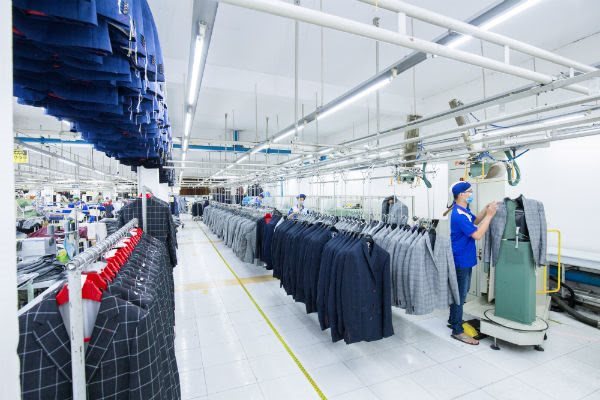Unlocking Vietnam’s digital future
Unlocking Vietnam’s digital future
With its great potential, Vietnam is marching towards becoming a modern nation with a digital economy amid the Industry 4.0 unfolding far and wide, which has major impacts on the business community.Over the past three years, Ousmane Dione, country director of the World Bank in Vietnam, has seen Vietnam change significantly with high technologies applied in many sectors of the economy, as Industry 4.0 sweeps across the globe.
“Disruptive technologies are here now in Vietnam,” said Dione. “I have seen strong growth of the digital economy with initial focus on services, for example the fast-growing ride-hailing industry, and the growth of e-commerce platforms that compete directly with traditional retail networks.”
Dione has also experienced the growth of digital accommodation platforms increasingly playing a role in tourism by competing with traditional hotels in large cities across the country, as well as the rising role of fintech and payment solution companies.
“This vibrant digital economy holds the promise of more micro-, small-, and medium-sized enterprises being able to participate in the Vietnamese economy. It is because e-commerce platforms expose these enterprises to larger markets and shortens the distance to them, especially for firms located farther from the main urban cities,” Dione added.
“The sharing economy means that the average Vietnamese person can participate more easily in the digital economy through using their homes to make an extra income through digital-accommodation platforms or using their motorcycles and cars on digital-technology-based ride hailing platforms.”
Access to Industry 4.0
The discourse revolving around Industry 4.0 in Vietnam was sparked in 2016 following domestic media coverage of the World Economic Forum Annual Meeting which was themed “Mastering the Fourth Industrial Revolution.”
This discourse, however, only started gaining momentum when remarks from governmental figures regarding Industry 4.0 emerged on the scene later in the year. Since then, it has witnessed participation from business circles, academics, and policymakers tackling different aspects of Industry 4.0 in Vietnam.
However, amid Industry 4.0, questions have been raised on how to ensure that the country’s economic growth continues to be rapid and sustainable.
According to the United Nations Development Programme, the search for suitable answers is key in the process of preparing the country’s Industry 4.0 strategy and 10-year Socio-Economic Development Strategy for the 2021-2030 period, against the background of the Sustainable Development Goals.
Friedrich-Ebert-Stiftung, a German political foundation which opened its Vietnamese office in Hanoi in 1990, said that over the last few years, the awareness of policymakers and the public in Vietnam has increased substantially on the opportunities and challenges that Industry 4.0 has been offering to the country’s development.
“It is the right time to formulate and undertake concrete actions to seize the unique opportunity for crafting a transition to anticipatory, adaptable, and agile governance to make Industry 4.0 inclusive,” said a Friedrich-Ebert-Stiftung report on Industry 4.0 and Vietnam. “It will also require to further build solid, deep-rooted foundations and Vietnam’s approach to long-term economic development, for long-term prosperity, human development, and environmental conditions for all Vietnamese people.”
Whether the technological transformation will generate leaps in productivity, creating new growth drivers and good employment for all Vietnamese and leads to a resilient, prosperous, and sustainable Vietnam where no-one is left behind depends greatly on the mobilisation of the potential and creativity of the government, businesses, investors, and people, the report concluded.
Enabling factors
Dione of the World Bank said, “While technology is potentially transformative, the three key enabling factors are policies, policies, and policies. Indeed, by establishing a conducive regulatory environment, the government can effectively facilitate and ensure that this promise turns into reality. I am very encouraged thus far by the increased focus of the government’s policies on disruptive technology and the digital economy within the context of Industry 4.0.”
In terms of digital adoption, Vietnam shows strengths and weaknesses. The World Bank’s Development Report 2016 on Digital Dividends ranked Vietnam’s Digital Adoption Index at 0.46 on a one-point scale. While higher than the average of global lower middle-income countries, it is lower than the regional average.
Internet penetration is 54.2 per cent, and 40 per cent of Vietnam’s population are social media users. And while those numbers are impressive, according to a recent survey from economic advisory firm Alphabeta, Vietnam fares lowest in the region in other digital measurements.
The World Bank suggested that to tap into the opportunities from Industry 4.0, Vietnam needs to grasp integrated digital solutions. Specifically, the government should adopt a holistic approach to how technology can support reforms for impact and transform its development outcomes.
For example, eastern European nation Estonia exploited Industry 4.0 opportunities at the start of its digital journey and as a result gained 2 per cent in its GDP. The system enables an Estonian to establish a company in less than 20 minutes. With over 99 per cent of state services online, Estonia boasts of saving 800 hours of working time every year through its system.
Impacts on enterprises
Vietnam’s workforce expects significant benefits such as improvement in operational efficiency as well as improved access to customers, largely from the digitisation and integration of value chains as well as digitisation of business models.
That is according to PricewaterhouseCoopers Consulting (Vietnam) Ltd.’s Industry 4.0 Vietnam Survey 2018, which was conducted with nearly 200 respondents, 15 of which are large companies with headcounts exceeding 3,000, and 56 per cent with revenues of VND100 billion ($4.35 million) or greater.
Under the survey, 67 per cent of respondents foresaw significant impacts of Industry 4.0 on their organisation’s operations within the next three years. Some 35 per cent expected faster product delivery and completion, and 23 per cent expected improved product quality.
Furthermore, 28 per cent hoped for improved access to customers, and 41 per cent anticipated the largest impact from digitisation of horizontal and vertical business value chains. Some 34 per cent indicated the largest impacts from the changing nature of digital business models and customer access, while almost a quarter reported to have already been affected by the industrial revolution.
In addition, according to a survey recently conducted by the Small- and Medium-sized Enterprise Association of Hanoi, regarding such enterprises’ awareness of Industry 4.0, 85 per cent of those surveyed showed an interest in Industry 4.0.
Among these, 55 per cent believed that Industry 4.0 will leave a profound impact on Vietnam’s economy, 23 per cent think the impact will be average, 11 per cent predict a marginal impact, and 6 per cent are as yet unsure of any impact.
When asked about strategies to prepare enterprises before Industry 4.0, 79 per cent said that they have not carried out any work in this regard. On the other hand, 55 per cent said they are learning about the matter, 19 per cent have plans to develop strategies accordingly, and 12 per cent said they have indeed implemented plans.
Among uninterested enterprises, 67 per cent said that Industry 4.0 is irrelevant to their businesses, 56 per cent believed their respective sectors will not feel much impact, and 76 per cent said they are not aware of Industry 4.0 and its features, while up to 54 per cent said it is unnecessary to pay attention to the issue at all.




















